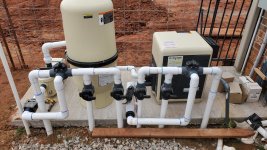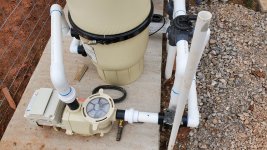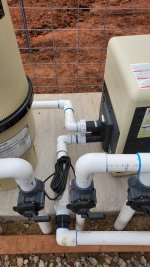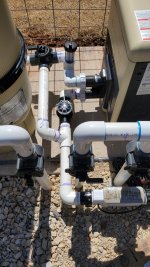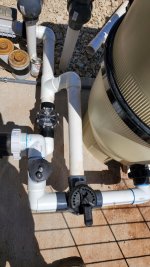After several years of a little 3000 gallon inflatable ring pool in my backyard, we finally jumped in for the proper in-ground pool last September. Constructed is finally nearing completion. There's additional construction going on on site or would have probably been done by now. The equipment has been set and plumbed a long time ago, and really the only thing left for the pool is the deck and plaster. I hadn't put much thought into the plumbing until recently.
The other day I was thinking that since I have a salt system and won't be using my heater a whole lot, that it might make sense to put a bypass on it. So I got to looking around and sure enough lots of people recommend instant the bypass. Seems the only reason not to is cost. Aaa Another thing I noticed is a lot of people put a check valve between the salt cell and the heater.
So when I went out to look at the system to see how difficult it was going to be to install a bypass, I noticed I did not have a check valve either. It seems installing a check valve and moving the salt cell and adding bypass is pretty straightforward. but just the fact that there was this much wrong has me wondering what else is wrong?
So here are some photos of my installation. I'm asking for help to identify any major problems that I definitely should request them to fix, as well as minor issues that could be better if done differently.
Thanks so much on advance.
The other day I was thinking that since I have a salt system and won't be using my heater a whole lot, that it might make sense to put a bypass on it. So I got to looking around and sure enough lots of people recommend instant the bypass. Seems the only reason not to is cost. Aaa Another thing I noticed is a lot of people put a check valve between the salt cell and the heater.
So when I went out to look at the system to see how difficult it was going to be to install a bypass, I noticed I did not have a check valve either. It seems installing a check valve and moving the salt cell and adding bypass is pretty straightforward. but just the fact that there was this much wrong has me wondering what else is wrong?
So here are some photos of my installation. I'm asking for help to identify any major problems that I definitely should request them to fix, as well as minor issues that could be better if done differently.
Thanks so much on advance.


